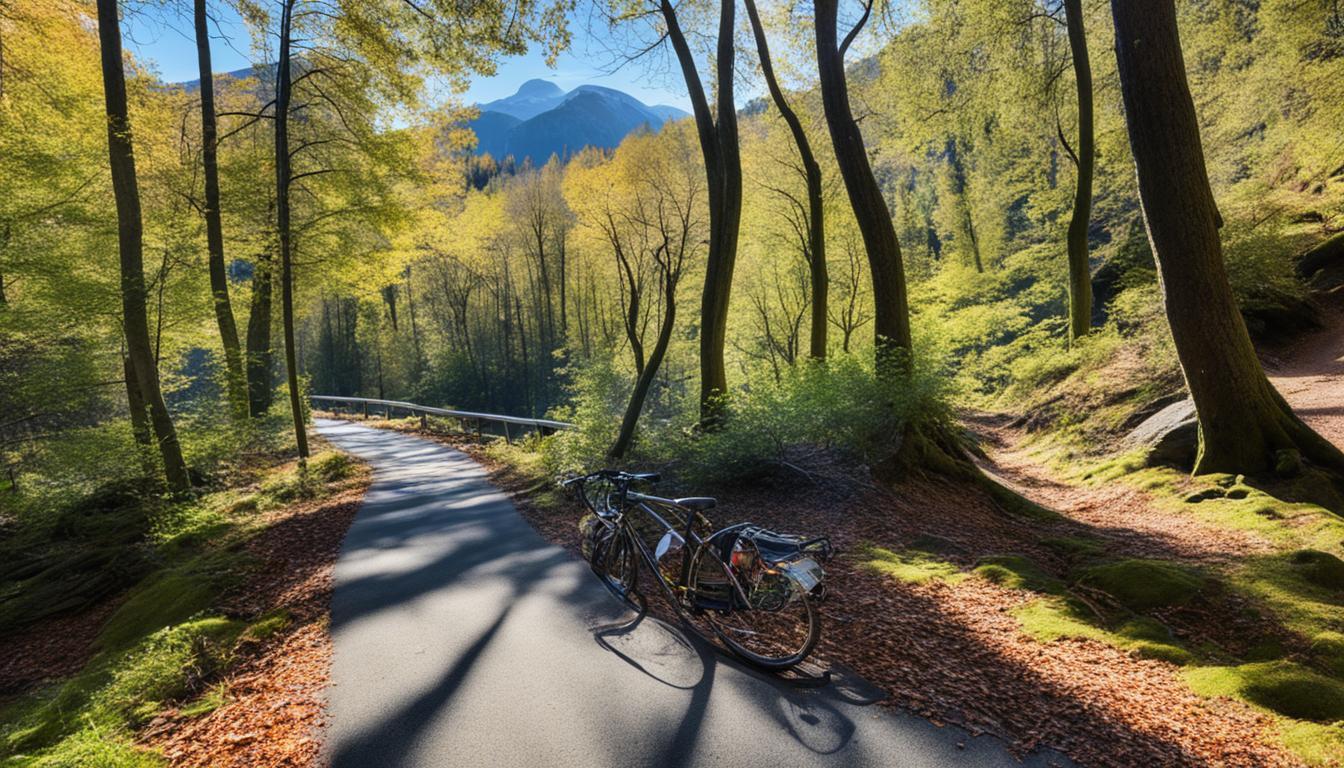Riding a bike is a favorite pastime for cycling enthusiasts in the US. Whether you’re a seasoned rider or just starting out, exploring new bike routes can add excitement and variety to your cycling adventures. In this article, we’ll share expert tips on getting the most out of your ride and discovering the top bike routes across the country.
Key Takeaways:
- Riding a bike is a popular activity among cycling enthusiasts in the US.
- Exploring new bike routes can enhance your cycling experience.
- Expert tips can help you improve your ride and make it more enjoyable.
- There are numerous scenic and challenging bike routes across the country.
- Stay tuned to discover the best bike routes and tips for your next cycling adventure.
Buying (or Renting) a Bike
If you’re in New York City and looking to ride, you have options for buying or renting a bike. Consider the benefits of each, such as convenience and cost.
When it comes to buying a bike in New York City, you can choose from a wide range of options. There are numerous bike shops throughout the city where you can find a variety of bikes to suit your needs. Whether you’re looking for a sleek road bike, a sturdy mountain bike, or a trendy fixie, you’ll have no shortage of choices.
Buying a bike offers the advantage of ownership. You can customize it to your liking and have the freedom to take it anywhere at any time. Additionally, purchasing a bike allows you to make a long-term investment in your cycling journey.
However, buying a bike may not be the best option for everyone. If you’re visiting New York City for a short period or plan to use a bike infrequently, renting a bike can be a more practical choice. Numerous bike rental shops can be found throughout the city, offering hourly, daily, or weekly rentals. This option allows you to experience the joy of cycling without the commitment of owning a bike.
Renting a bike is especially convenient for tourists who want to explore New York City’s iconic sights on two wheels. You can rent a bike near popular attractions like Central Park or the Brooklyn Bridge, making it easy to hop on and start your adventure.
The Benefits of Buying
Buying a bike in New York City comes with several benefits:
- Customization: You can choose the exact specifications, style, and size of your bike to ensure the perfect fit.
- Long-term investment: Owning a bike allows you to embark on countless cycling adventures, exploring the city at your own pace.
- Convenience: Having your own bike means you have the freedom to cycle whenever and wherever you want.
The Benefits of Renting
Renting a bike in New York City offers its own set of advantages:
- Flexibility: Renting a bike provides the flexibility to choose your rental duration, whether it’s for a few hours or several days.
- Convenience: Bike rental shops are strategically located near popular attractions, making it easy to start your exploring right away.
- Cost-effective: Renting a bike can be a more cost-effective option, especially if you only plan to use it occasionally.
Deciding whether to buy or rent a bike ultimately depends on your individual needs and preferences. Consider factors such as your cycling frequency, budget, and storage options before making a decision. Both options offer unique benefits that can enhance your experience of riding in New York City.
Bike Lanes and Paths in New York

New York City is a haven for cyclists, with its extensive network of bike lanes and paths catering to riders of all skill levels. Whether you’re a seasoned cyclist or a novice, you’ll find a variety of options to explore the city on two wheels. The city’s commitment to providing safe and accessible cycling routes has made it easier than ever to navigate the bustling streets.
One of the most iconic bike lanes in New York City is the Brooklyn Waterfront Greenway. Stretching for 14 miles along the Brooklyn shoreline, this scenic route offers breathtaking views of the Manhattan skyline, the Statue of Liberty, and the East River. It’s perfect for leisurely rides, daily commutes, or as a starting point to explore other parts of the city.
Another popular bike path is the Hudson River Greenway, which runs parallel to the Hudson River on the west side of Manhattan. This path spans over 11 miles and is a favorite among cyclists for its stunning waterfront views and proximity to iconic landmarks such as the Intrepid Sea, Air & Space Museum and Riverside Park.
If you’re looking for a longer ride, the Central Park Loop is a must-visit destination. This 6.1-mile loop circles around the iconic Central Park, offering a traffic-free oasis in the heart of the city. With its tree-lined paths, rolling hills, and picturesque landscapes, it’s an ideal spot for both leisurely rides and intense workouts.
Exploring New York City by bike is not only a great way to stay active, but it also allows you to discover hidden gems and experience the city from a unique perspective. The bike lanes and paths offer a convenient and enjoyable way to navigate the bustling streets, while enjoying the sights and sounds of the city.
| Bike Lane/Path | Location | Length | Highlights |
|---|---|---|---|
| Brooklyn Waterfront Greenway | Brooklyn | 14 miles | Manhattan skyline views, Statue of Liberty |
| Hudson River Greenway | Manhattan | 11 miles | Hudson River views, Intrepid Museum |
| Central Park Loop | Manhattan | 6.1 miles | Central Park, scenic landscapes |
These are just a few examples of the many bike lanes and paths you can explore in New York City. Whether you’re seeking a leisurely ride along the waterfront, a scenic route through a park, or a convenient way to commute, the city has something to offer every cyclist. So grab your bike, map out your route, and embark on an adventure through the bustling streets of New York City.
Getting Around by Bike in New York
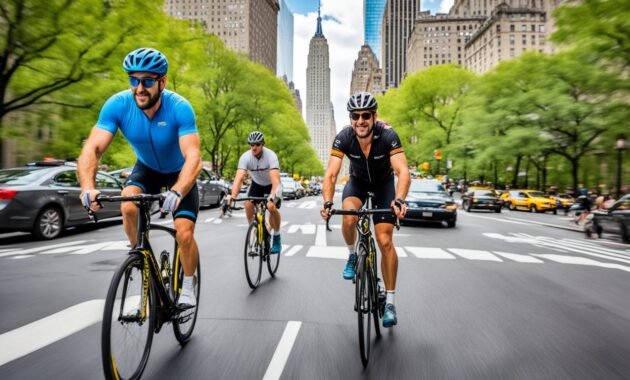
When it comes to exploring New York City, biking is a great way to get around and experience the city’s vibrant energy. With its extensive network of bike lanes and paths, you can easily navigate through the bustling streets and iconic landmarks. But what if you need to travel a longer distance or simply want to take a break from pedaling? Don’t worry, there are bike commuting options that allow you to combine the convenience of biking with other modes of transportation.
Riding with Your Bike on the Subway
New York City’s subway system is one of the most efficient ways to travel within the city. And the good news is, you can bring your bike with you on the subway! Some subway lines allow bikes outside of rush hours, typically during off-peak times. Be sure to check the specific rules and restrictions for each subway line before planning your journey. This way, you can seamlessly transition from biking to the subway and continue your commute with ease.
Bikes and Buses
Buses are another option for bike commuters in New York City. Many buses have front-mounted bike racks that can accommodate one or two bikes at a time. This makes it convenient to combine your bike ride with a bus trip, especially if you need to cover longer distances or navigate through areas with limited bike infrastructure. Just load your bike onto the rack, hop on the bus, and continue your journey seamlessly.
Commuter Lines for Bikers
If your bike commute takes you outside of the city, commuter lines provide a convenient way to travel with your bike. Metro-North and Long Island Rail Road allow bikes on select trains, typically during off-peak hours. This opens up opportunities for bike commuters to reach destinations beyond the city limits, whether it’s for work or leisure. Just imagine biking along scenic routes and exploring new areas outside of the concrete jungle.
“Combining biking with other modes of transportation can offer the best of both worlds – the freedom and flexibility of biking, along with the convenience and reach of public transportation.”
| Transportation Method | Advantages | Disadvantages |
|---|---|---|
| Subway | – Allows you to cover longer distances – Easy access to various parts of the city |
– Restricted hours for bikes – Limited space during peak times |
| Buses | – Front-mounted bike racks available – Can accommodate longer trips |
– Limited space for bikes – Bus schedules may vary |
| Commuter Lines | – Access to destinations beyond the city – Scenic routes for enjoyable rides |
– Limited bike capacity – Off-peak hours only |
Combining biking with other modes of transportation can offer the best of both worlds – the freedom and flexibility of biking, along with the convenience and reach of public transportation. Whether you’re commuting to work, exploring the city, or venturing beyond, these bike commuting options allow you to make the most out of your journey. So grab your bike and start discovering New York City in a whole new way!
Rules and Safety Tips for Biking in New York
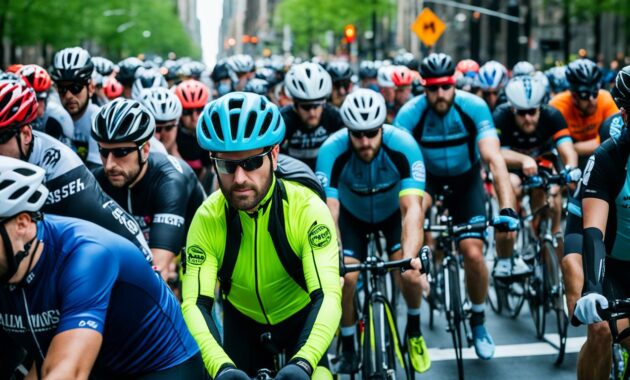
Biking in New York City can be an exciting and convenient way to navigate the urban landscape. However, it’s crucial to be aware of the bike laws and prioritize safety to ensure a smooth and enjoyable ride.
When riding in New York City, it is important to remember that bicycles are considered vehicles under New York State law. This means that you must adhere to traffic rules and regulations, just like motorists. Familiarize yourself with the bike laws specific to New York City to ensure you are in compliance and avoid any potential fines or penalties.
Key Bike Laws in New York City
Here are some of the important bike laws you should be aware of:
- Signal your turns: Use hand signals to indicate when you are turning left or right to alert other road users of your intentions. It is crucial to communicate your movements to ensure a safe riding experience.
- Obey traffic signals: Stop at red lights and wait for green lights before proceeding. Treat stop signs as you would when driving a car.
- Ride in the right direction: Always ride in the same direction as traffic. Avoid riding against the flow of traffic, as it can be dangerous and increase the risk of accidents.
- Use bike lanes and paths: Whenever possible, ride in designated bike lanes and paths. These dedicated spaces provide a safer riding environment and reduce conflicts with vehicles.
- Sharing the road: Be mindful of sharing the road with other vehicles, including cars, trucks, and buses. Maintain a safe distance, and avoid abrupt maneuvers to prevent accidents.
- Biking on sidewalks: In New York City, biking on sidewalks is generally illegal unless specifically designated as shared pedestrian-bike paths. Respect pedestrians’ space and use bike lanes or the road when available.
By following these bike laws, you can help create a safer cycling environment for everyone on the road. Remember, safety should be your top priority when biking in the busy streets of New York City.
When it comes to bike safety, there are additional tips you should keep in mind:
- Always wear a helmet: Protect your head and brain by wearing a helmet while riding. Find a well-fitting helmet that meets safety standards to ensure maximum protection.
- Stay visible: Use lights and reflective gear, especially when riding at night or in low-light conditions. Make yourself visible to drivers and pedestrians to avoid accidents.
- Stay alert and focused: Keep your attention on the road and your surroundings. Avoid distractions like headphones or using your phone while riding.
- Be predictable: Signal your intentions clearly and in advance. Avoid sudden movements that may confuse other road users.
- Maintain your bike: Regularly check your bike’s brakes, tires, and other components to ensure they are in good working condition. A well-maintained bike is safer and more reliable.
“When biking in New York City, it’s crucial to follow the bike laws and prioritize safety. By observing traffic rules, staying visible, and being proactive in maintaining your bike, you can enjoy a safe and enjoyable journey through the city.” – [Author Name]
| Bike Laws | Bike Safety Tips |
|---|---|
| Ride in the same direction as traffic | Always wear a helmet |
| Obey traffic signals | Stay visible with lights and reflective gear |
| Signal your turns | Stay alert and focused |
| Use bike lanes and paths | Be predictable in your movements |
| Avoid biking on sidewalks | Maintain your bike regularly |
Bike Maintenance and Care
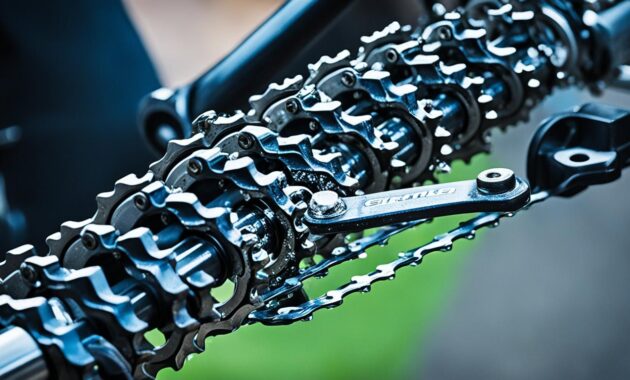
Proper bike maintenance and care are essential for a smooth and safe ride. By regularly checking your bike and performing basic maintenance tasks, you can ensure that your bike is in good condition, prolong its lifespan, and enhance your overall cycling experience.
Pre-Ride Bike Check
Before each ride, take a few moments to inspect key components of your bike. This quick check can help prevent minor issues from turning into major problems during your ride.
- Tire Pressure: Ensure that your tires are properly inflated. Correct tire pressure not only improves performance but also reduces the risk of flats.
- Brakes: Test your brakes to ensure they are responsive and functioning properly. Squeeze the brake levers and ensure that the brake pads make contact with the rim or disc.
- Chain: Check the chain for any signs of rust, dirt, or wear. If necessary, clean and lubricate it to ensure smooth shifting and pedaling.
- Gears: Shift through all the gears to make sure they are engaging smoothly. Adjust the derailleurs if needed.
- Lights and Reflectors: Verify that your lights and reflectors are in working order, especially if you plan on riding during low-light conditions.
Basic Bike Maintenance Tasks
Regular bike maintenance helps prevent breakdowns and keeps your bike running smoothly. Here are some basic maintenance tasks you can perform at home:
- Cleaning: Clean your bike regularly, especially after riding in wet or muddy conditions. Use a mild detergent and water to remove dirt and grime.
- Lubrication: Apply lubrication to essential moving parts such as the chain, derailleur, and brake pivots. This helps prevent wear and ensures smooth operation.
- Wheel Truing: Check the wheels for any wobbles or unevenness. Use a spoke wrench to adjust the tension and true the wheel if necessary.
- Bearing Check: Inspect the headset, bottom bracket, and wheel bearings for any play or roughness. If needed, repack the bearings with grease.
- Brake Pad Replacement: Regularly check the brake pads for wear. Replace them if they are worn down to ensure optimal braking performance.
Proper Bike Storage
Proper storage is crucial for keeping your bike in good condition, especially during times when you’re not riding it. Follow these tips for storing your bike:
“Store your bike in a dry and sheltered area, away from extreme temperatures. If possible, hang it on a wall-mounted bike rack or use a floor stand to prevent unnecessary stress on the frame. Keep the tires inflated properly and cover the bike to protect it from dust and debris.”
| Maintenance Task | Frequency |
|---|---|
| Tire Pressure Check | Before every ride |
| Chain Lubrication | Every 100-200 miles or as needed |
| Brake Pad Inspection | Monthly |
| Wheel Truing | As needed |
| Bearing Check | Every 6-12 months |
By incorporating these maintenance tasks into your biking routine, you can keep your bike in optimal condition, minimize the risk of breakdowns, and ensure an enjoyable and safe ride every time.
Choosing the Right Bike for Your Needs
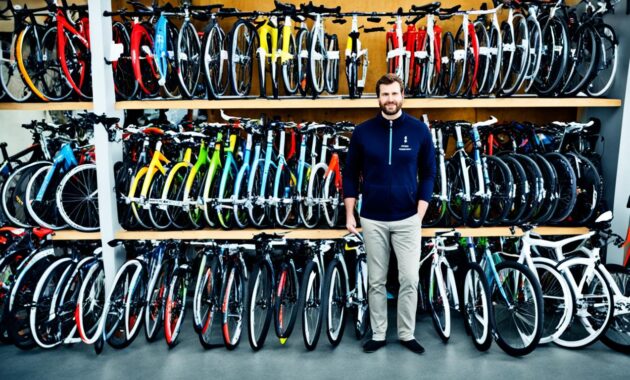
Choosing the right bike is crucial for a comfortable and enjoyable ride. Whether you’re into road cycling, mountain biking, or gravel cycling, finding the perfect bike can make all the difference in your cycling experience. Here, we’ll explore the different types of bikes available and help you determine which one suits your needs best.
Types of Bikes
When it comes to choosing a bike, there are several options to consider:
- Road Bikes: Designed for speed and performance on paved roads, road bikes are lightweight and feature drop handlebars for an aerodynamic riding position. They are perfect for road cycling enthusiasts who enjoy long-distance rides and fast-paced riding.
- Mountain Bikes: Built to handle rough terrains, mountain bikes are equipped with durable frames, suspension forks, and knobby tires for optimal traction. They are ideal for off-road adventures and mountain biking enthusiasts looking for excitement and challenging trails.
- Gravel Bikes: Combining the features of road and mountain bikes, gravel bikes are versatile and can handle a variety of terrains, including gravel roads, dirt trails, and even pavement. They offer a comfortable riding position and wider tires for added stability on mixed surfaces.
Factors to Consider
When choosing a bike, it’s important to consider the following factors:
- Your Riding Style: Determine the type of cycling you plan to do most often. Are you primarily interested in road cycling, mountain biking, or gravel cycling?
- Terrain: Consider the terrain you’ll be riding on. Will you be cycling mostly on paved roads, off-road trails, or a mix of both? This will help you determine the appropriate bike type.
- Comfort: Ensure that the bike you choose provides a comfortable riding position and fits your body properly. The right bike size and frame geometry can greatly enhance your comfort during long rides.
- Features: Take into account the specific features you may need, such as gears, suspension, disc brakes, and tire width. These features can enhance performance and make your rides more enjoyable.
- Budget: Set a budget and look for bikes within that range. While it’s important to invest in a quality bike, you don’t want to overspend on features that you won’t fully utilize.
Choosing the Perfect Bike
To make an informed decision, visit local bike shops and test ride different models. This will allow you to experience the bike’s handling, comfort, and overall fit. Additionally, consult with knowledgeable staff who can provide guidance based on your riding goals and preferences.
“Finding the right bike is like finding a partner. It should match your needs, support your adventures, and make you fall in love with cycling all over again.”
Remember, the perfect bike is the one that suits your needs and brings joy to your rides. By considering the type of cycling you enjoy and the factors mentioned above, you’ll be on your way to finding the ideal bike for your cycling adventures.
Comparing Different Bike Types
| Bike Type | Road Bikes | Mountain Bikes | Gravel Bikes |
|---|---|---|---|
| Primary Use | Smooth paved roads, long-distance rides, and speed. | Off-road trails, rough terrains, and adrenaline-inducing descents. | Mixed terrains, including gravel, dirt, and pavement. |
| Frame and Geometry | Lightweight, aerodynamic frame with drop handlebars. | Durable frame with suspension forks and upright riding position. | Versatile frame geometry for stability and comfort. |
| Tires | Slick or lightly treaded tires for optimal speed. | Knobby tires with excellent traction on uneven surfaces. | Wider tires with moderate tread for versatility. |
| Brakes | Rim brakes or disc brakes for precise stopping power. | Disc brakes for reliable stopping in all conditions. | Disc brakes for consistent performance on mixed terrains. |
| Gears | Higher number of gear options for efficient pedaling on paved roads. | Wide range of gears for climbing steep hills and navigating challenging terrains. | Varied gear options for a balance of climbing and speed on different surfaces. |
Essential Cycling Gear
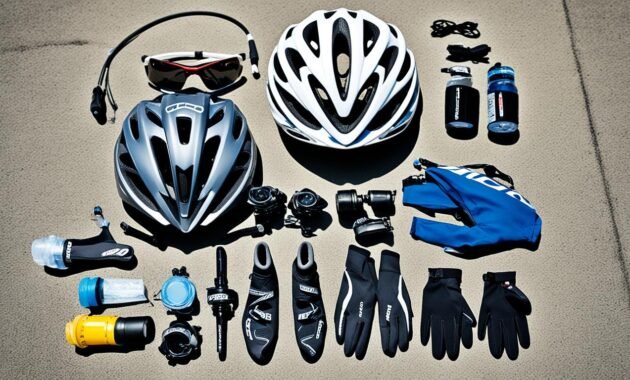
Cycling is a thrilling activity that requires the right gear to enhance your comfort and performance on the bike. Whether you’re an avid cyclist or just starting out, investing in essential cycling gear can make your rides more enjoyable. Here are a few key items that every cyclist should consider:
Helmets
One of the most important pieces of cycling gear is a high-quality helmet. A helmet protects your head in case of accidents and reduces the risk of severe injuries. Look for a helmet that fits properly, has adjustable straps, and meets safety standards. Remember, safety should always be a priority when riding.
Cycling Clothes
Wearing the right clothing is crucial for both comfort and performance during your rides. Cycling clothes are designed to be breathable, moisture-wicking, and provide a full range of motion. Consider investing in padded shorts to minimize discomfort during long rides. Additionally, wearing bright and reflective clothing can improve visibility and safety on the road.
Bike Shoes
Investing in a pair of bike shoes can greatly enhance your cycling experience. Bike shoes are designed with stiff soles that improve power transfer and efficiency while pedaling. They also have specialized cleats that can be attached to your pedals, providing a secure connection and better control over your bike. Choose bike shoes that fit well and are compatible with your pedal system.
Tip: When shopping for cycling gear, try them on in person whenever possible to ensure the perfect fit and comfort.
Including the right cycling gear in your riding routine can significantly improve your overall experience on the bike. With a well-fitted helmet, appropriate clothing, and proper bike shoes, you can ride with confidence, comfort, and style.
Now, let’s take a look at a table comparing the features of different cycling helmets:
| Helmet Brand | Weight | Adjustable Fit | Ventilation |
|---|---|---|---|
| Giro | 250g | Yes | 20 vents |
| Bell | 280g | Yes | 25 vents |
| Specialized | 230g | Yes | 18 vents |
| Bontrager | 270g | Yes | 22 vents |
Remember, the right cycling gear can make a world of difference in your riding experience. Invest in high-quality gear that fits correctly and meets your specific needs. Happy cycling!
Benefits of Cycling for Physical and Mental Health
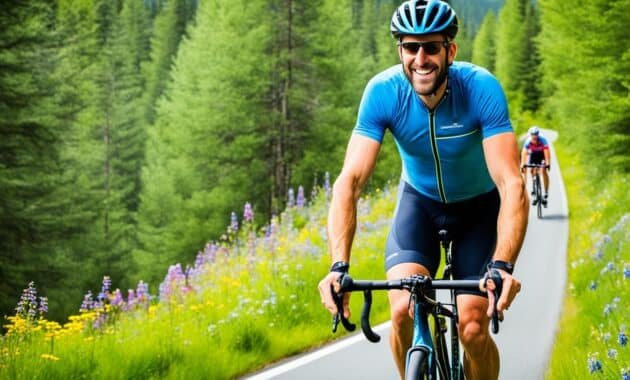
Cycling offers numerous benefits for physical and mental health. Regular cycling can have a positive impact on cardiovascular health, weight management, and mental well-being. Let’s explore these benefits in more detail:
Improved Cardiovascular Health
Cycling is a great way to improve cardiovascular fitness. It helps strengthen the heart muscles, increases lung capacity, and improves circulation. Regular cycling can lower the risk of cardiovascular diseases such as heart attacks, strokes, and high blood pressure. By challenging your cardiovascular system, cycling helps improve endurance and overall stamina.
Effective Weight Management
For those looking to manage their weight, cycling is an excellent choice. It is a low-impact exercise that can help burn calories and shed unwanted pounds. Cycling increases metabolic rate, builds muscle mass, and boosts fat burning. It helps improve body composition, reduces body fat, and increases muscle tone. Whether you’re cycling outdoors or using a stationary bike, consistent cycling can contribute to weight loss and weight maintenance.
Enhanced Mental Well-being
Cycling is not just beneficial for the body; it also has positive effects on mental health. Engaging in regular physical activity like cycling triggers the release of endorphins, which are feel-good hormones that help reduce stress, alleviate symptoms of anxiety and depression, and improve overall mood. Cycling outdoors can be particularly beneficial as it allows you to connect with nature, enjoy fresh air, and experience a sense of freedom and tranquility.
“Cycling is the closest thing to flying that we have.” – Robin Williams
Whether you’re cycling for leisure, commuting to work, or participating in organized rides, the benefits for physical and mental health are undeniable. The combination of cardiovascular exercise, weight management, and the release of endorphins makes cycling a holistic activity that promotes overall well-being.
Take a moment to appreciate the beauty of cycling:
| Physical Health Benefits | Mental Health Benefits |
|---|---|
| Improved cardiovascular fitness | Reduced stress and anxiety |
| Weight management and fat burning | Improved mood and well-being |
| Increased muscle tone and strength | Elevated self-esteem and confidence |
| Enhanced endurance and stamina | Boosted cognitive function |
By enjoying the physical and mental benefits of cycling, you can lead a healthier, happier life. So hop on your bike, explore new routes, and reap the rewards of this invigorating activity.
Different Types of Cycling
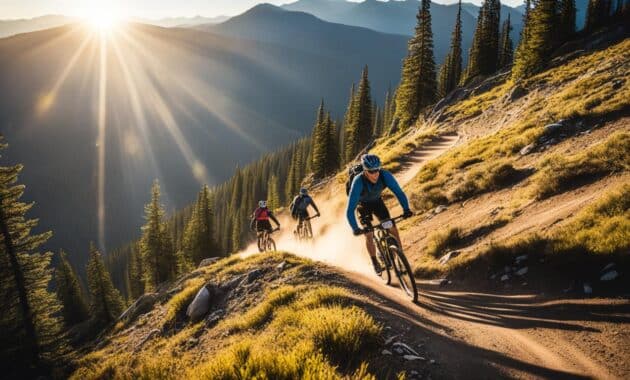
When it comes to cycling, there are various types that cater to different preferences and fitness levels. Whether you’re a road cycling enthusiast seeking the thrill of speed, a mountain biking enthusiast craving adventurous trails, or a gravel cycling enthusiast yearning for off-road exploration, there’s something for everyone. Let’s explore the unique experiences and challenges offered by each type:
Road Cycling
Road cycling is all about the open road and speed. It involves riding on smooth paved surfaces, such as highways and country roads. Road cyclists often focus on endurance, covering long distances while maintaining a steady pace. This type of cycling can be competitive, with races and group rides creating a sense of camaraderie among riders.
Mountain Biking
For those who crave adventure and off-road challenges, mountain biking is the perfect choice. Mountain bikers ride on uneven terrain, tackling hills, trails, and even obstacles like rocks and tree roots. This type of cycling requires technical skills, balance, and agility. Mountain biking offers a connection with nature and an adrenaline rush as you conquer steep descents and navigate through challenging landscapes.
Gravel Cycling
Gravel cycling combines elements of road and mountain biking, offering a unique experience for cyclists seeking versatility. Gravel cyclists ride on unpaved roads, typically composed of gravel, dirt, or crushed stone. It allows riders to explore scenic routes that may not be accessible by road bike. Gravel cycling can provide a sense of adventure and the opportunity to discover hidden gems in nature.
“Cycling allows you to explore different landscapes and challenge yourself physically. Whether you prefer the speed of road cycling, the thrill of mountain biking, or the versatility of gravel cycling, each type offers a rewarding experience.”
Now that you’re familiar with the different types of cycling, consider your interests, fitness goals, and desired level of adventure. Choose the type that resonates with you and immerse yourself in the joy of two wheels.
| Type | Surface | Challenges |
|---|---|---|
| Road Cycling | Paved roads | Endurance, speed |
| Mountain Biking | Trails, uneven terrain | Technical skills, obstacles |
| Gravel Cycling | Unpaved roads | Versatility, exploration |
Embark on your cycling journey and explore the diverse world of road cycling, mountain biking, and gravel cycling. Each type offers its own adventure, allowing you to push your limits and experience the thrill of two wheels.
Cycling Tips for Beginners
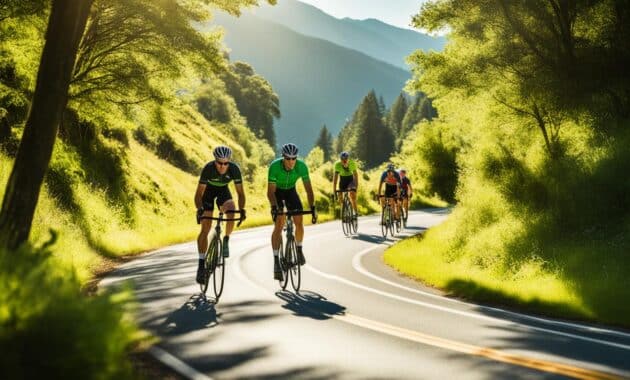
If you’re new to cycling and excited to embark on your two-wheeled adventures, here are some essential tips to help you get started and make the most of your beginner cyclist journey. From bike handling skills to route planning, these practical tips will ensure a smooth and enjoyable ride:
- Bike handling skills are key: Familiarize yourself with basic bike handling skills such as starting, stopping, and balancing. Practice in a safe and open area, gradually building your confidence and control. Remember to maintain a relaxed grip on the handlebars and keep your eyes focused ahead.
- Follow traffic rules: As a cyclist, it’s important to obey traffic laws and ride responsibly. Ride in the same direction as traffic, signal your intentions, and stop at red lights and stop signs. Stay vigilant and be aware of your surroundings to ensure your safety and the safety of others.
- Stay hydrated and fuel up: Cycling is a physically demanding activity, so it’s crucial to stay hydrated and fuel your body properly. Carry a water bottle and take sips regularly throughout your ride. Pack some snacks like energy bars or fruits to replenish your energy levels on longer rides.
- Plan your cycling routes: Before heading out, plan your cycling routes in advance. Look for bike-friendly roads or designated bike paths in your area. Consider using cycling apps or online maps that provide information about bike lanes and low-traffic routes. Exploring new routes can add excitement and variety to your rides.
Remember, cycling is not just about the physical activity—it’s also an opportunity to connect with nature, explore new places, and enjoy the freedom of the open road. So hop on your bike, follow these beginner cycling tips, and embrace the joy of pedaling into a world of adventure.
Also Read : Top 10 Different Types Of Bike Choices For Every Rider
Conclusion
For cycling enthusiasts, riding a bike is more than just a hobby – it’s a passion that brings joy and fulfillment. By following the right tips and exploring the best ride routes, you can elevate your cycling experience and make the most out of this popular activity in the US.
Whether you’re a beginner or an experienced rider, these tips can help you enhance your skills and maximize your enjoyment. Remember to always prioritize safety by wearing a helmet, following traffic rules, and sharing the road responsibly with other users.
With an abundance of scenic routes and diverse terrains, there are endless options for cyclists to explore. From rolling countryside roads to challenging mountain trails, each ride offers its own unique charm. So get on your bike, pick a route that suits your preferences, and start pedaling towards new adventures.
So, what are you waiting for? Grab your bike, gather your friends or embark on a solo journey, and experience the freedom and thrill of cycling. With the right tips and ride routes, there are endless possibilities for you to discover as a cycling enthusiast in the US.
FAQs
Q: What are some essential tips for beginners to enjoy a bike ride?
A: Beginners should start with short rides to build endurance gradually, invest in a quality helmet and other protective gear, adjust the bike to fit their body properly, and familiarize themselves with traffic rules and hand signals.
Q: Can you recommend some scenic routes for cycling enthusiasts?
A: Some popular routes for cyclists include the California Highway 1 from San Francisco to Los Angeles, the Loire Valley in France, the Great Ocean Road in Australia, and the Tuscany region in Italy.
Q: How can I find cycling tours to join as a solo rider?
A: You can search for cycling tours on websites like TripAdvisor, Cycling Tours World, and REI Adventures where you can find group tours that solo riders can join to explore new destinations.
Q: Is it important to check the weather forecast before planning a bike ride?
A: Yes, checking the weather forecast is crucial to ensure a safe and enjoyable bike ride. Avoid cycling in extreme weather conditions and always be prepared with appropriate gear for different weather scenarios.
Q: What should I consider when planning a long-distance bike tour?
A: When planning a long-distance bike tour, consider factors such as the route terrain, available accommodations along the way, food and water supply points, spare bike parts, emergency contacts, and a detailed map of the route.
Q: How can I stay motivated during long rides or challenging terrains?
A: To stay motivated during long rides or challenging terrains, create a cycling playlist with your favorite upbeat songs, set achievable goals, ride with a companion for support, reward yourself after completing milestones, and visualize the feeling of accomplishment at the end of the journey.
Q: Is it recommended to carry a spare tire or repair kit during bike rides?
A: Yes, it is highly recommended to carry a spare tire, repair kit, and basic tools like a pump, tire levers, and patch kit in case of a flat tire or other mechanical issues during your bike rides.
Q: What are some tips for a beginner cyclist?
A: Start with short rides to build endurance, always wear a helmet, obey traffic rules, and make sure your bike is properly maintained.
Q: How can I find cycling routes in my area?
A: Look for cycling clubs or websites dedicated to cycling in your location, use GPS-enabled apps like Strava or Google Maps, or ask local bike shops for recommendations.
Q: Are there any must-have accessories for long bike rides?
A: Some essential accessories for long rides include a comfortable saddle, padded shorts, water bottles, a repair kit, and lights for visibility.
Q: Can I listen to music while cycling?
A: It is recommended to avoid using headphones while cycling for safety reasons. However, you can use a portable speaker or a bone conduction headphone that doesn’t cover your ears.
Q: Where can I find cycling-related videos?
A: You can find cycling-related videos on platforms like YouTube by searching for keywords like “cycling tips,” “bike routes,” or “professional cycling races.”
Q: How can I participate in a cycling event?
A: Check out local cycling clubs or websites for upcoming events, register online if required, and make sure to train and prepare adequately for the specific type of event.
Q: Is there a specific date for the next major cycling event in my area?
A: To find out the date of the next major cycling event, visit official cycling event websites, check with local cycling organizations, or search for news articles related to cycling events in your area.
Source Links
- https://www.bicycling.com/skills-tips/a23708797/nyc-bike-map/
- https://www.bicycling.com/training/a20021391/best-cycling-tips/
- https://hincapie.com/blogs/stories-from-the-saddle/how-to-get-into-cycling-15-beginner-cycling-tips
